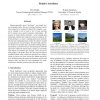Free Online Productivity Tools
i2Speak
i2Symbol
i2OCR
iTex2Img
iWeb2Print
iWeb2Shot
i2Type
iPdf2Split
iPdf2Merge
i2Bopomofo
i2Arabic
i2Style
i2Image
i2PDF
iLatex2Rtf
Sci2ools
ICCV
2011
IEEE
2011
IEEE
Relative Attributes
Human-nameable visual “attributes” can benefit various recognition tasks. However, existing techniques restrict these properties to categorical labels (for example, a person is ‘smiling’ or not, a scene is ‘dry’ or not), and thus fail to capture more general semantic relationships. We propose to model relative attributes. Given training data stating how object/scene categories relate according to different attributes, we learn a ranking function per attribute. The learned ranking functions predict the relative strength of each property in novel images. We then build a generative model over the joint space of attribute ranking outputs, and propose a novel form of zero-shot learning in which the supervisor relates the unseen object category to previously seen objects via attributes (for example, ‘bears are furrier than giraffes’). We further show how the proposed relative attributes enable richer textual descriptions for new images, which in practice are more precise fo...
| Added | 11 Dec 2011 |
| Updated | 11 Dec 2011 |
| Type | Journal |
| Year | 2011 |
| Where | ICCV |
| Authors | Devi Parikh, Kristen Grauman |
Comments (0)

